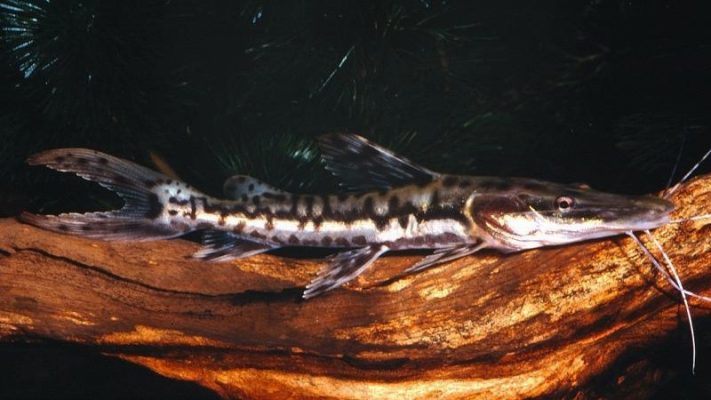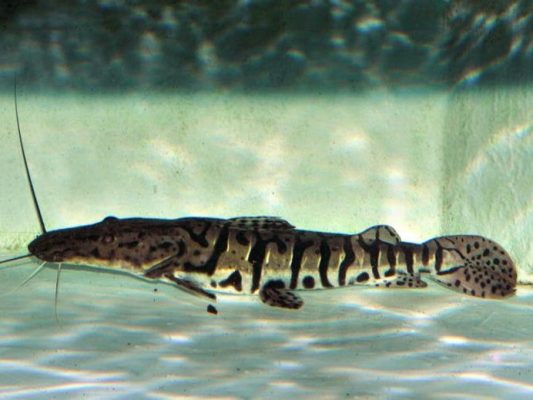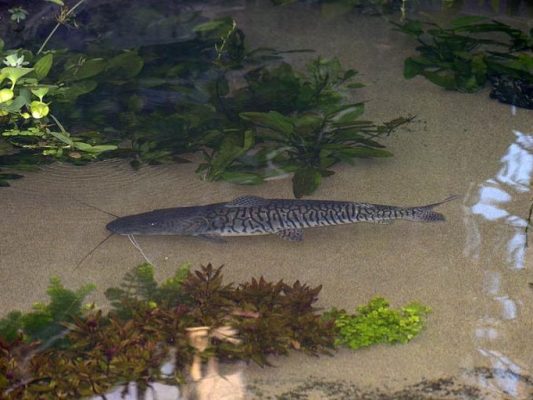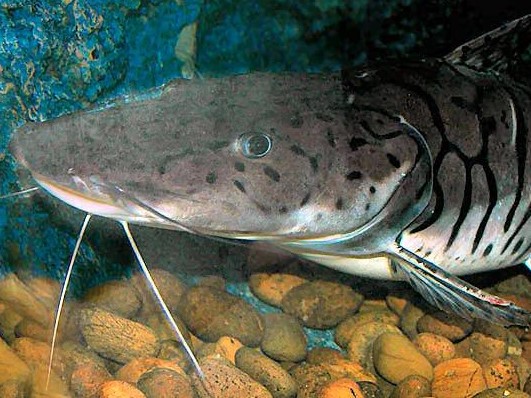Barred Sorubim

Table of Contents
- Introduction
- Taxonomy and Classification
- Physical Characteristics
- Behavior and Reproduction
- Ecology and Interactions
- Conclusion
Introduction
The Barred Sorubim, scientifically known as Pseudoplatystoma fasciatum, is a captivating and highly sought-after species among fish enthusiasts. With its striking appearance and unique characteristics, this fish has captured the attention of both amateur and professional aquarists. Its popularity can be attributed to its impressive size, intriguing behavior, and remarkable ecological importance.
In the vast and complex aquatic ecosystem, the Barred Sorubim plays a crucial role in maintaining the delicate balance of nature. As a predatory species, it helps regulate the population of smaller fish, ensuring the stability and health of the ecosystem. By controlling the abundance of prey species, the Barred Sorubim contributes to the overall biodiversity and functioning of the aquatic environment.
The purpose of this article is to provide a comprehensive overview of the Barred Sorubim, shedding light on its taxonomy, physical characteristics, habitat, behavior, ecological interactions, conservation status, economic value, and ongoing scientific studies. By delving into these aspects, we aim to deepen our understanding of this remarkable species and raise awareness about the importance of its conservation.
The Barred Sorubim belongs to the family Pimelodidae, which comprises a diverse group of catfish species. Within this family, it is classified under the genus Pseudoplatystoma. The species name, fasciatum, refers to the distinct barred pattern that adorns its body. This classification not only helps us categorize the Barred Sorubim but also provides insights into its evolutionary history and genetic relationships with other species.
The scientific name of the Barred Sorubim, Pseudoplatystoma fasciatum, is widely recognized and used by researchers and fish enthusiasts alike. However, it is worth noting that this species is also known by various common names depending on the region. Some of these include “Tiger Sorubim,” “Striped Sorubim,” and “Barred Catfish.” These alternative names reflect the distinct physical characteristics that make this species easily recognizable.
Through phylogenetic analysis, scientists have determined that the Barred Sorubim is closely related to other species within the Pseudoplatystoma genus. This group of catfishes is known for their elongated body shape, predatory behavior, and adaptability to various aquatic habitats. By understanding the phylogenetic relationships of the Barred Sorubim, researchers can gain insights into its evolutionary history and its place within the broader catfish family.
The Barred Sorubim possesses a striking appearance that distinguishes it from other fish species. Its body is elongated and cylindrical, with a streamlined shape that enables it to move swiftly through the water. The most notable feature of the Barred Sorubim is its distinctive barred pattern, which consists of dark vertical stripes running along its body. These bars are set against a lighter background, creating a visually captivating contrast.
The Barred Sorubim is known for its impressive size, making it a true spectacle in the aquatic world. On average, it can reach lengths of up to {average length} cm, although some individuals have been recorded to exceed this size. In terms of weight, mature Barred Sorubim can weigh several kilograms, further highlighting their substantial presence in the water. Its robust body structure, combined with its muscular build, allows it to navigate swiftly and efficiently through its habitat.
One of the defining characteristics of the Barred Sorubim is its distinct barred pattern. This pattern, consisting of dark vertical stripes, extends from the head to the tail, creating a visually stunning display. The elongated body shape of the Barred Sorubim is a common feature among catfish species, enabling them to maneuver through various aquatic environments with ease. This adaptation has contributed to the success of the Barred Sorubim in its natural habitat.
Stay tuned for the next section, where we will explore the habitat and distribution of the Barred Sorubim.
Taxonomy and Classification
The Barred Sorubim, scientifically known as Pseudoplatystoma fasciatum, belongs to the family Pimelodidae, commonly referred to as the catfish family. This family includes various species of catfish found in freshwater habitats around the world.
Pseudoplatystoma fasciatum is also known by several other names, including the Barred Sorubim, Banded Sorubim, and Tiger Sorubim. These names reflect its distinctive physical characteristics, such as the prominent barred pattern on its body.
Within the catfish family, the Barred Sorubim is classified under the genus Pseudoplatystoma. This genus consists of large predatory catfish species that are native to South America. The species name, fasciatum, refers to the Latin word “fascia,” meaning “band” or “stripe,” which accurately describes the fish’s unique markings.
Phylogenetically, the Barred Sorubim belongs to the order Siluriformes, commonly known as catfish. This order encompasses a diverse group of fish species characterized by their barbels and lack of scales. Within the order Siluriformes, the Barred Sorubim is further classified into the suborder Pimelodoidei, which includes various catfish species found in South America.
The Barred Sorubim shares a close evolutionary relationship with other species within the genus Pseudoplatystoma, such as the Pseudoplatystoma corruscans, commonly known as the Spotted Sorubim. These species share similar physical characteristics and ecological roles within their respective habitats.
Understanding the taxonomy and classification of the Barred Sorubim provides a foundation for further exploration of its biology, behavior, and ecological significance. By studying its phylogenetic relationships, scientists can gain insights into the evolutionary history and ecological adaptations of this remarkable species.
Physical Characteristics
The Barred Sorubim, scientifically known as Pseudoplatystoma fasciatum, is a visually striking fish species that captivates fish enthusiasts with its unique features. With its elongated body and characteristic barred pattern, it bears a resemblance to other catfish species while still maintaining its distinct identity.
In terms of size, the Barred Sorubim can grow to impressive lengths. On average, it reaches a length of {average length} cm, although some individuals have been recorded to exceed this size. This makes it one of the larger catfish species in the aquatic ecosystem.
One of the most notable physical features of the Barred Sorubim is its characteristic barred pattern. These dark, vertical bars run along the length of its body, creating a visually striking contrast against its lighter-colored background. These bars serve as a form of camouflage, allowing the fish to blend into its surroundings and remain hidden from potential predators or prey.
The elongated body of the Barred Sorubim is another distinguishing characteristic. This streamlined shape enables the fish to move swiftly through the water, making it an efficient predator. Its body is well-adapted for its predatory nature, allowing it to navigate through various aquatic environments with ease.
Additionally, the Barred Sorubim possesses a set of sensory organs called barbels, which are located around its mouth. These barbels aid in the fish’s ability to locate and capture prey, as they are highly sensitive to vibrations and can detect changes in the water.
The coloration of the Barred Sorubim varies depending on its environment and age. Juveniles often display a lighter coloration, while adults tend to have a darker hue. This color variation further contributes to the fish’s ability to blend into its surroundings and remain inconspicuous.
Another interesting physical characteristic of the Barred Sorubim is its fin structure. It possesses a dorsal fin, which runs along the top of its body, and an adipose fin, located towards the rear of its body. These fins provide stability and maneuverability, allowing the fish to navigate through different water currents and environments.
It is important to note that while the Barred Sorubim shares physical similarities with other catfish species, its unique combination of features sets it apart and makes it easily recognizable to fish enthusiasts and researchers alike.
In conclusion, the Barred Sorubim exhibits a range of physical characteristics that contribute to its overall appearance and functionality in the aquatic ecosystem. Its elongated body, characteristic barred pattern, and sensory barbels make it a visually striking and efficient predator. The fish’s fin structure and coloration further enhance its ability to navigate through various aquatic environments. Understanding and appreciating these physical characteristics not only adds to our knowledge of this species but also highlights the importance of protecting and conserving its unique place in the aquatic ecosystem.
Habitat and Distribution
Preferred Habitat of the Barred Sorubim
The Barred Sorubim, also known as Pseudoplatystoma fasciatum, is predominantly found in freshwater environments, particularly in riverbeds, streams, and flooded areas. These habitats provide the ideal conditions for the species to thrive due to the abundance of prey and suitable shelter. The Barred Sorubim is well-adapted to these dynamic aquatic ecosystems, where it can navigate through various water depths and currents.
Geographical Distribution of the Barred Sorubim
The Barred Sorubim has a wide distribution range, primarily found in South America. It is native to several countries, including Brazil, Colombia, Venezuela, and Peru. Within these regions, it inhabits the major river systems such as the Amazon, Orinoco, and Paraná. The species has also been introduced to other parts of the world, including the United States, where it has established populations in certain states like Florida.
Environmental Requirements for Survival
The survival of the Barred Sorubim is closely linked to specific environmental conditions. One crucial requirement is the availability of forests and shady areas, which provide essential cover and protection for the species. These areas offer refuge from direct sunlight and help regulate water temperature, which is crucial for the Barred Sorubim’s physiological processes.
Additionally, the Barred Sorubim thrives in habitats with ample vegetation, as it provides a rich food source and serves as a spawning ground. The presence of submerged aquatic plants and fallen trees creates a complex habitat structure that allows the species to exhibit its natural behaviors, such as hunting and reproduction.
Furthermore, the Barred Sorubim is highly dependent on the availability of suitable prey species, such as smaller fish, crustaceans, and insects. Therefore, the health and abundance of these prey populations directly impact the survival and overall population dynamics of the Barred Sorubim.
Scientific studies have shown that alterations to the natural habitat, such as deforestation, dam construction, and pollution, can have detrimental effects on the Barred Sorubim’s survival. These human-induced disturbances disrupt the delicate balance of the aquatic ecosystem, leading to habitat degradation and a decline in the species’ population.
In conclusion, the Barred Sorubim exhibits a strong association with riverbeds, streams, and flooded areas, where it finds suitable shelter, abundant prey, and favorable environmental conditions. Its geographical distribution spans several South American countries, with the species being particularly prevalent in major river systems. To ensure the long-term survival of the Barred Sorubim, it is crucial to protect its preferred habitats, conserve the surrounding forests, and maintain the health of the aquatic ecosystem as a whole.
Behavior and Reproduction
Behavior and Feeding Habits:
The Barred Sorubim, also known as Pseudoplatystoma fasciatum, exhibits fascinating behavior and feeding habits that contribute to its survival and ecological role. This species is primarily nocturnal, displaying increased activity during the night when it actively hunts for prey. This behavior allows the Barred Sorubim to take advantage of the cover of darkness and effectively navigate its environment.
When it comes to feeding, the Barred Sorubim is a formidable predator. It possesses a highly developed sensory system, including a keen sense of smell and excellent vision, which enables it to locate and capture its prey with precision. This species primarily feeds on small fish, crustaceans, and other aquatic invertebrates. Its diet may also include insects, mollusks, and occasionally, smaller amphibians.
To capture its prey, the Barred Sorubim employs various hunting techniques. It often relies on ambush tactics, patiently waiting in concealed locations such as submerged logs or vegetation, before swiftly striking at unsuspecting prey. Its elongated body and powerful musculature allow for quick and agile movements, ensuring a successful capture.
Predatory Nature and Hunting Techniques:
The Barred Sorubim’s predatory nature is evident in its physical adaptations and hunting techniques. With its streamlined body and sharp, backward-facing teeth, it is well-equipped to seize and secure its prey. Its large mouth and expandable stomach allow it to consume relatively large prey items, further demonstrating its role as an apex predator in its ecosystem.
One of the most remarkable hunting techniques employed by the Barred Sorubim is its ability to produce low-frequency sounds known as “drumming.” This behavior involves the rapid contraction of specialized muscles near its swim bladder, creating a series of distinctive drum-like sounds. It is believed that this drumming behavior helps the Barred Sorubim to communicate with conspecifics and potentially stun or disorient prey.
Reproductive Behavior:
The reproductive behavior of the Barred Sorubim is a fascinating aspect of its life cycle. This species typically reaches sexual maturity at approximately {age} years, although variations in maturity age have been observed based on environmental factors and individual growth rates. Once sexually mature, the Barred Sorubim engages in elaborate mating rituals to attract a suitable mate.
During the mating season, which typically occurs during the rainy season in their natural habitat, male Barred Sorubim engage in courtship displays to attract females. These displays may involve fin flaring, body movements, and vocalizations. Once a suitable mate is chosen, the pair engages in spawning behavior.
Spawning for the Barred Sorubim usually takes place in shallow areas with dense vegetation or submerged structures. The female releases her eggs, and the male fertilizes them externally. After fertilization, the eggs are left to develop and hatch on their own. The parental care provided by the Barred Sorubim is limited, with no further involvement in the offspring’s development.
In conclusion, the behavior and reproduction of the Barred Sorubim are intricately linked to its survival and ecological role. Its nocturnal feeding habits, predatory nature, and hunting techniques showcase its adaptability and effectiveness as a predator. Additionally, its reproductive behavior, including mating rituals and spawning habits, contribute to the continuation of its species. Understanding these aspects of the Barred Sorubim’s life cycle is crucial for appreciating its significance in the aquatic ecosystem and implementing effective conservation measures to ensure its long-term survival.
Ecology and Interactions
The Barred Sorubim (Pseudoplatystoma fasciatum): A Crucial Player in the Aquatic Food Chain
The Barred Sorubim (Pseudoplatystoma fasciatum) plays a crucial role in the aquatic food chain, serving as both a predator and prey species. As a top predator, it helps regulate fish populations by preying on smaller fish species, thus maintaining a balanced ecosystem. Its voracious appetite and hunting techniques make it a formidable predator in the water.
Adaptations and Predator-Prey Dynamics
In addition to its role as a predator, the Barred Sorubim also serves as prey for larger predatory species. Its elongated body and characteristic barred pattern provide camouflage and protection against potential predators. This species has evolved to adapt to its environment, allowing it to thrive in various ecosystems.
Adaptations to Flooded Areas and Forests
The Barred Sorubim exhibits specific adaptations to environmental conditions, particularly in flooded areas and forests. During the rainy season, when rivers and streams flood, the Barred Sorubim takes advantage of the increased water levels to expand its habitat and access new food sources. It has the ability to navigate through flooded forests and feed on prey that may be sheltering among the submerged vegetation.
Positive Impact on the Ecosystem
Recent studies have shown that the Barred Sorubim’s presence in these flooded areas has a positive impact on the ecosystem. By preying on smaller fish, it helps control their populations, preventing overpopulation and ensuring the survival of other species. This predation pressure also encourages smaller fish to adapt and develop strategies to avoid becoming prey, leading to increased biodiversity within the aquatic ecosystem.
Symbiotic Relationships and Interactions
Furthermore, the Barred Sorubim’s interactions with other species extend beyond its role as a predator or prey. It has been observed engaging in symbiotic relationships with certain fish species. For example, it has been documented that the Barred Sorubim forms mutualistic associations with cleaner fish, where the cleaner fish remove parasites and dead skin from the Barred Sorubim’s body, benefiting both species involved.
The Importance of the Barred Sorubim for Ecosystem Health
These interactions and adaptations highlight the intricate web of relationships within the aquatic ecosystem, emphasizing the importance of the Barred Sorubim’s presence for the overall health and balance of the ecosystem.
Conclusion
The Barred Sorubim (Pseudoplatystoma fasciatum) is a fascinating and significant species among fish enthusiasts, with its unique characteristics and ecological importance in the aquatic ecosystem. Throughout this comprehensive overview, we have delved into various aspects of this remarkable fish, including its taxonomy, physical characteristics, habitat and distribution, behavior and reproduction, ecology and interactions, conservation status and threats, economic and recreational value, as well as research and scientific studies.
The taxonomic classification of the Barred Sorubim reveals its place within the catfish family, with its scientific name Pseudoplatystoma fasciatum. Understanding its phylogenetic relationships and classification sheds light on its evolutionary history and genetic connections to other species.
In terms of physical characteristics, the Barred Sorubim boasts a distinctive appearance, characterized by its elongated body and characteristic barred pattern. It can reach an impressive size and weight, with an average length of {average length} cm, making it a formidable presence in its habitat.
Speaking of habitat and distribution, the Barred Sorubim prefers riverbeds, streams, and flooded areas, where it thrives in specific environmental conditions such as forests and shady areas. Its geographical distribution spans regions and countries where it occurs, further adding to its ecological significance.
When it comes to behavior and reproduction, the Barred Sorubim exhibits nocturnal feeding habits and displays predatory nature with its hunting techniques. It becomes sexually mature at approximately {age} years, engaging in mating rituals and spawning habits that contribute to its population dynamics.
The Barred Sorubim plays a crucial role in the aquatic food chain, impacting fish populations and interacting with other species as both predator and prey. Its adaptations to environmental conditions, such as flooded areas and forests, further highlight its ecological importance.
However, the Barred Sorubim faces various threats to its survival, including habitat loss and overfishing. Its conservation status necessitates ongoing efforts and initiatives to protect this remarkable species. Fortunately, there are ongoing conservation initiatives in place that aim to safeguard its future.
Beyond its ecological significance, the Barred Sorubim holds economic value in fishing industries and is a popular sport fish among anglers. Regulations and restrictions on fishing are crucial to ensure sustainable practices and maintain its population.
Notable research and scientific studies have shed light on the biology, behavior, and conservation of the Barred Sorubim. Recent discoveries and advancements have contributed to our understanding of this species, emphasizing the importance of ongoing scientific studies for further knowledge and conservation efforts.
In conclusion, the Barred Sorubim is a remarkable fish species that plays a vital role in the aquatic ecosystem. Its unique characteristics, ecological importance, and economic value make it a species worth appreciating and protecting. Further research and conservation efforts are essential to ensure its long-term survival. Let us join hands in appreciating and protecting the Barred Sorubim, ensuring a sustainable future for this remarkable species.



